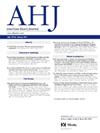Obicetrapib Demonstrates Significant Deductions of LP(A) on Top of High-Intensity Statins
IF 3.7
2区 医学
Q1 CARDIAC & CARDIOVASCULAR SYSTEMS
引用次数: 0
Abstract
Background and Aims: Elevated lipoprotein (a) [Lp(a)] leads to increased cardiovascular disease (CVD) risk. There are no pharmacologic therapies approved for reducing Lp(a). Previous cholesteryl ester transfer protein (CETP) inhibitors and approved lipid agents have modest Lp(a) effects. We examined the effects of obicetrapib, a novel CETP inhibitor, on Lp(a).
Methods: ROSE1 and ROSE2 are phase 2 trials of obicetrapib on top of high-intensity statins by persons without CVD and low-density lipoprotein cholesterol >70 mg/dL. In ROSE1 120 subjects received 5 or 10 mg obicetrapib or placebo; in ROSE2 119 received 10 mg obicetrapib, 10 mg obicetrapib + 10 mg ezetimibe or placebo. Lp(a) was measured by immunoturbidimetry in ROSE1 and by the UCSD isoform independent assay using monoclonal antibody LPA-KIV9 in ROSE2.
Results: Median baseline Lp(a) for 10 mg obicetrapib and placebo was 29.9 and 45.3 nmol/L in ROSE1 and 44.0 and 37.8 nmol/L in ROSE2, respectively. Median % changes from baseline for obicetrapib 10 mg and placebo, respectively, were -56.5 and +4.00 in ROSE1 and -47.2 and +2.3 in ROSE2. Pooled (N=127) median difference in % change corrected for placebo was 57.1% (p<0.001). In both trials >50% of obicetrapib subjects had a >60% reduction in Lp(a).
Conclusions: Obicetrapib 10 mg on top of high-intensity statin significantly lowered Lp(a) by 57% vs. placebo in a pooled analysis, a substantially greater reduction than with proprotein convertase subtilisin kexin type 9 inhibitors (15-30%), niacin (30%) or other CETP inhibitors (25%).
求助全文
约1分钟内获得全文
求助全文
来源期刊

American heart journal
医学-心血管系统
CiteScore
8.20
自引率
2.10%
发文量
214
审稿时长
38 days
期刊介绍:
The American Heart Journal will consider for publication suitable articles on topics pertaining to the broad discipline of cardiovascular disease. Our goal is to provide the reader primary investigation, scholarly review, and opinion concerning the practice of cardiovascular medicine. We especially encourage submission of 3 types of reports that are not frequently seen in cardiovascular journals: negative clinical studies, reports on study designs, and studies involving the organization of medical care. The Journal does not accept individual case reports or original articles involving bench laboratory or animal research.
 求助内容:
求助内容: 应助结果提醒方式:
应助结果提醒方式:


